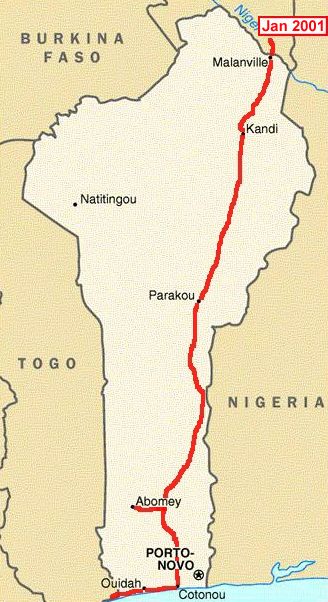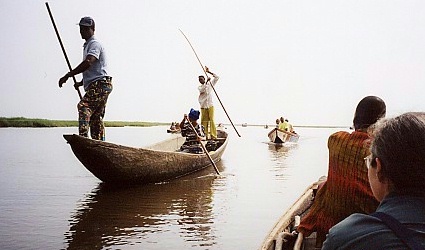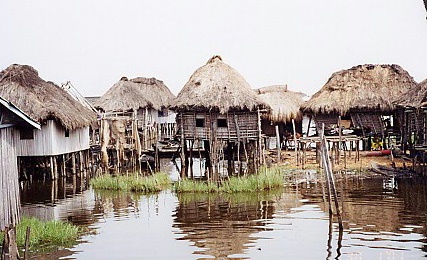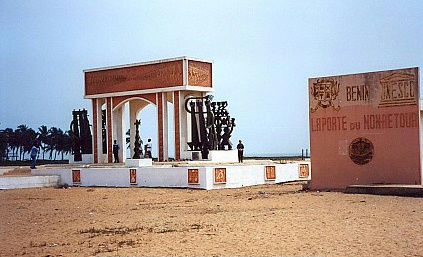Travel Through Benin on a Harley-Davidson
By Peter & Kay Forwood
Benin on a Harley (25/1/01 - 1/2/01)
Distance 889 km (219299 km to 220188 km)
This is part of the Seventh section of our around the
world trip.
Complete Trip Overview & Map
Coming from Niger
 25/1/01 Out of the big countries and into a run of small
ones starting with Benin. The further west we head the more sophisticated
and civilized things become and the border crossing just 20 minutes. Immediately
the place wealthier with signs of prosperity including a new sealed road
to Kandi for the night. People still carry their own food bowl to eat at
small street stalls but gone are the children hoping to fill it from the
leftovers of your meal. The dry harmattan wind blowing dust to choke the
sinuses and make the throat as dry as burnt toast. Our skin is starting to
feel like parched leather and we probably look ten years older than we are.
It's no wonder the desert people wear turbans across the mouth and nose revealing
only the eyes.
25/1/01 Out of the big countries and into a run of small
ones starting with Benin. The further west we head the more sophisticated
and civilized things become and the border crossing just 20 minutes. Immediately
the place wealthier with signs of prosperity including a new sealed road
to Kandi for the night. People still carry their own food bowl to eat at
small street stalls but gone are the children hoping to fill it from the
leftovers of your meal. The dry harmattan wind blowing dust to choke the
sinuses and make the throat as dry as burnt toast. Our skin is starting to
feel like parched leather and we probably look ten years older than we are.
It's no wonder the desert people wear turbans across the mouth and nose revealing
only the eyes.
26/1/01 Further south to Abomey, 500 km, burning oil at
300 km to the litre and black smoke. Not much alternative but to press on
at least to Cotonou, the capital, to try repairs. A loose exhaust bracket
and engine vibration succeeded in severing the exhaust pipe just behind the
rear cylinder. A bit noisy but otherwise of little effect. The people gradually
getting shorter and heavier featured moving away from the Arabic, African
look. Camels disappear along with sheep and the goat's legs stumpier moving
to more fertility.
27/1/01 Removed the exhaust and had it oxy welded using
oxygen and carbide gas. The quality of repair barely acceptable, near enough
more than good enough. In the same workshop a Mercedes engine had been dismembered
on the dusty floor, with the crank case removed, dust attracted to its oil
as if to a magnet. Other vehicles in various states of disrepair littered
the yard, convinced us we had no choice but to travel the 150 km and look
at repairs in Cotonou. A visit to the interesting Abomey museum with its
history going back 12 kings to the mid 1600's filled the remaining part of
the day.
28/1/01 The rattle we thought was in the engine had actually
been the slow breaking of the exhaust pipe so we travelled to Cotonou more
at ease. A spread out city requiring thousands of motorcycle taxis for movement.
Almost all smoke billowing 50 cc two strokes lined up at traffic lights for
the slow amble down wide boulevards. Sedate dense moving traffic at about
40 km per hour. As with most ex-communist/Marxist countries in Africa there
are few beggars and great adoption of private enterprise with small stalls
everywhere down to the man walking the streets with two glasses, coffee and
a thermos or a shoe shine man.  Sit in a street bar or restaurant for 10 minutes and be politely offered
a wide range of clothes, electrical fittings, tools, belts, clocks, coats
and trousers. If they don't have your size they know where to get it and will
be back in minutes. The owners of the bars have long ago given up on chasing
them, but they are not too pushy.
Sit in a street bar or restaurant for 10 minutes and be politely offered
a wide range of clothes, electrical fittings, tools, belts, clocks, coats
and trousers. If they don't have your size they know where to get it and will
be back in minutes. The owners of the bars have long ago given up on chasing
them, but they are not too pushy.
29/1/01 Ghana visa, four application forms and four photos,
who knows what they do with that many, internet and change travellers cheques.
We don't often need to change travellers cheques, thank goodness. We paid
2% commission for the privilege of standing in line for 20 minutes, the girl
closed her window to go to lunch just as we were next, so we start to queue
again. Customer service hasn't arrived here with government or ex-government
enterprises and people complain little probably having long ago given up.
They get crammed into taxi's or shuffled from place to place. The educated
middle class however is starting to vote with their feet and businesses will
very soon have to change. 
30/1/01 Over 200 years ago the Tofinu people fled from
the Fon people and having nowhere to go and knowing the Fon's fear of swimming
they set up a village on stilts in the middle of a large coastal lake. Today
there are 30,000 people living in stilt houses and cultivating the lake fish
by feeding and growing them on rotting branches and leaves in the lake's
shallow waters. We took a guide with his dug-out canoe through the fish cultivation
plots to the stilt village which boasts a hospital, hotel and post office.
Fresh water now comes from a deep well but originally had to be brought from
surrounding streams.
31/1/01 Ouidah, just 40 km, a place where slaves and with
them voodoo were exported to the U.S.A., Haiti and Brazil. Voodoo seems like
many exported cultures to be stronger in the new homeland than the old place
of origin. Over one million slaves were shipped out of the port at the rate
of 10,000 a year for 100 years. It was not only the west who profited from
the slaves with the local kings capturing and selling theirs and neighbouring
tribesmen. It's a four km walk from the old Portuguese fort to the monument of no return.
This is the route the slaves took in chains, the last time they would see
Africa, before being squeezed into the hold of a ship. Judging by the numbers
of requests we get from people wanting to go to the west some would probably
have wished their ancestors were the ones that had been exported to the U.S.A.
It's a four km walk from the old Portuguese fort to the monument of no return.
This is the route the slaves took in chains, the last time they would see
Africa, before being squeezed into the hold of a ship. Judging by the numbers
of requests we get from people wanting to go to the west some would probably
have wished their ancestors were the ones that had been exported to the U.S.A.
1/2/01 Engines don't repair themselves, but somehow the
cracked and broken exhaust was effecting our oil consumption either through
overheating, or less back pressure, as oil consumption has reduced since the
exhaust repair. The jury is still out. Not being mechanics we are only guessing.
Followed the coast route to the Togo border, polite and friendly.
Move with us to Togo
 25/1/01 Out of the big countries and into a run of small
ones starting with Benin. The further west we head the more sophisticated
and civilized things become and the border crossing just 20 minutes. Immediately
the place wealthier with signs of prosperity including a new sealed road
to Kandi for the night. People still carry their own food bowl to eat at
small street stalls but gone are the children hoping to fill it from the
leftovers of your meal. The dry harmattan wind blowing dust to choke the
sinuses and make the throat as dry as burnt toast. Our skin is starting to
feel like parched leather and we probably look ten years older than we are.
It's no wonder the desert people wear turbans across the mouth and nose revealing
only the eyes.
25/1/01 Out of the big countries and into a run of small
ones starting with Benin. The further west we head the more sophisticated
and civilized things become and the border crossing just 20 minutes. Immediately
the place wealthier with signs of prosperity including a new sealed road
to Kandi for the night. People still carry their own food bowl to eat at
small street stalls but gone are the children hoping to fill it from the
leftovers of your meal. The dry harmattan wind blowing dust to choke the
sinuses and make the throat as dry as burnt toast. Our skin is starting to
feel like parched leather and we probably look ten years older than we are.
It's no wonder the desert people wear turbans across the mouth and nose revealing
only the eyes.  Sit in a street bar or restaurant for 10 minutes and be politely offered
a wide range of clothes, electrical fittings, tools, belts, clocks, coats
and trousers. If they don't have your size they know where to get it and will
be back in minutes. The owners of the bars have long ago given up on chasing
them, but they are not too pushy.
Sit in a street bar or restaurant for 10 minutes and be politely offered
a wide range of clothes, electrical fittings, tools, belts, clocks, coats
and trousers. If they don't have your size they know where to get it and will
be back in minutes. The owners of the bars have long ago given up on chasing
them, but they are not too pushy. 
 It's a four km walk from the old Portuguese fort to the monument of no return.
This is the route the slaves took in chains, the last time they would see
Africa, before being squeezed into the hold of a ship. Judging by the numbers
of requests we get from people wanting to go to the west some would probably
have wished their ancestors were the ones that had been exported to the U.S.A.
It's a four km walk from the old Portuguese fort to the monument of no return.
This is the route the slaves took in chains, the last time they would see
Africa, before being squeezed into the hold of a ship. Judging by the numbers
of requests we get from people wanting to go to the west some would probably
have wished their ancestors were the ones that had been exported to the U.S.A.